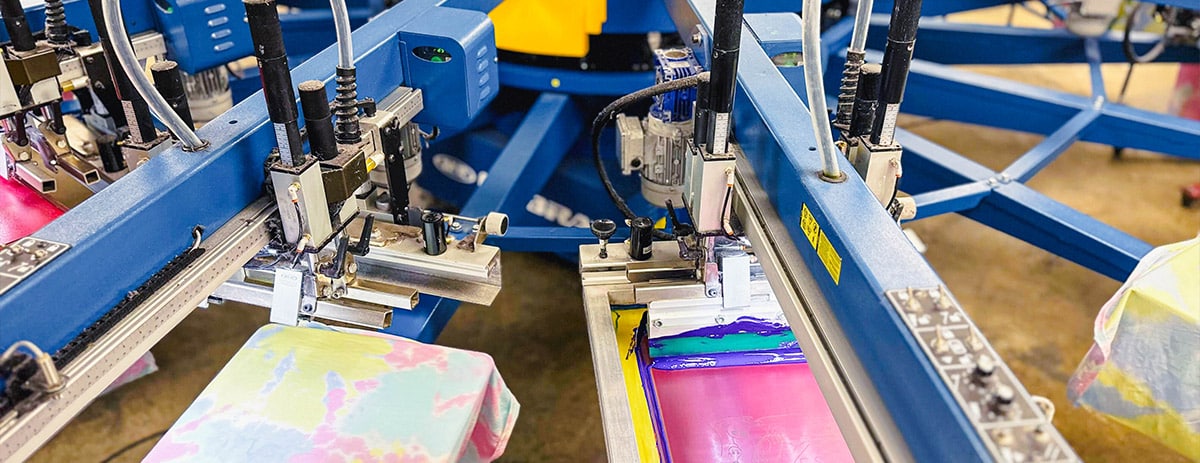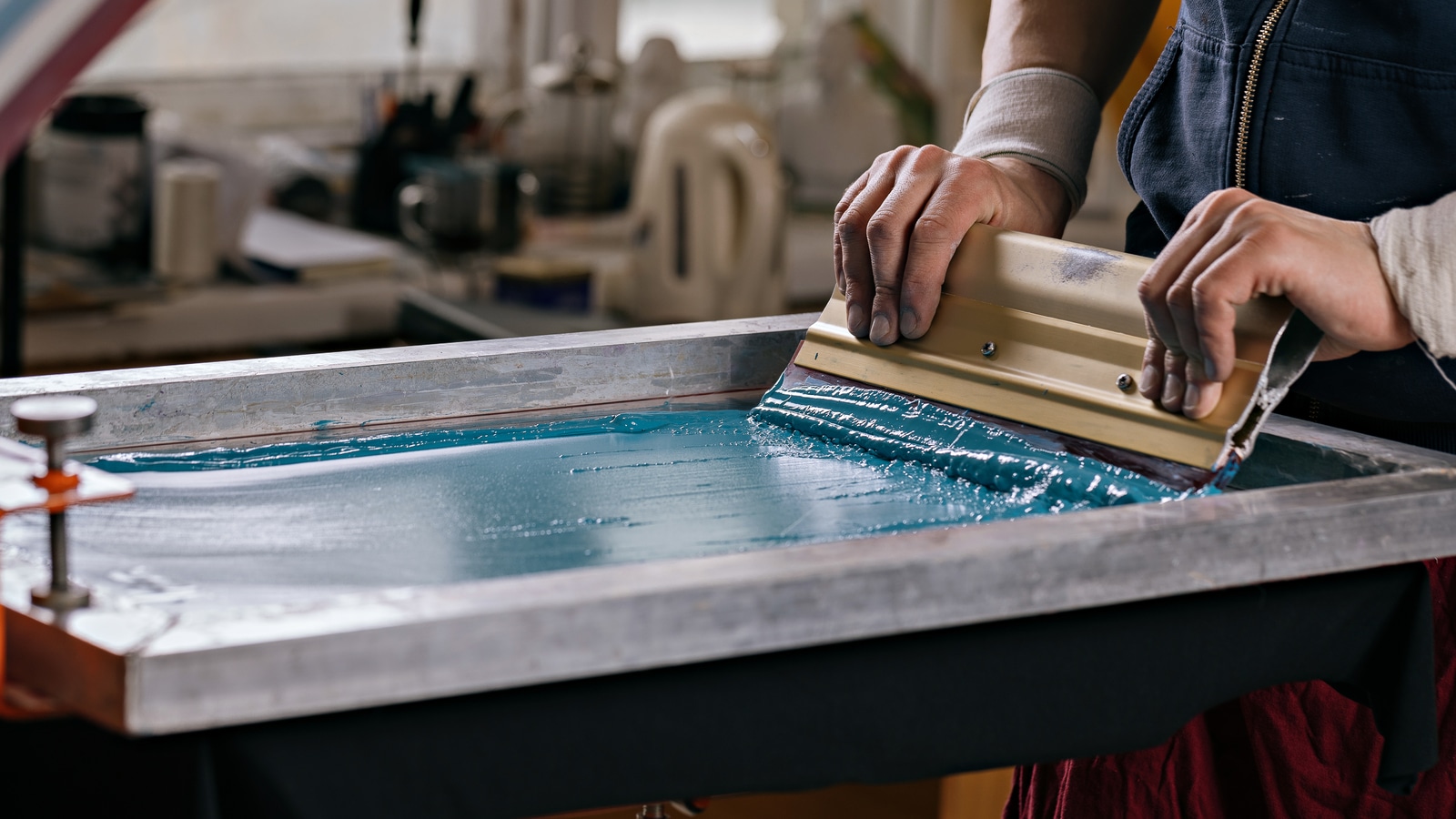Vintage Style Silk Screen Printing for Retro Fashion
Vintage Style Silk Screen Printing for Retro Fashion
Blog Article
Screen Printing Uncovered: Whatever You Required to Learn About T-Shirt and Garment Printing Techniques
If you've ever asked yourself exactly how those dynamic styles end up on your preferred tee shirts, you're in the right location. Screen printing is a remarkable technique that integrates art with method, using limitless opportunities for imagination. Understanding the fundamentals, from tools to ink selections, can considerably affect your results. Ready to discover the crucial components that make display printing an art kind? Allow's discover the information that can raise your jobs.
The Essentials of Screen Printing: Just How It Works
When you plunge right into screen printing, you'll find it's both a scientific research and an art. At its core, display printing includes creating a pattern, or screen, that enables ink to go through just in specific areas (screen printing kit). You begin by selecting your layout and preparing your screen with a light-sensitive solution. Once you reveal this emulsion to light, it solidifies, leaving your design as an adverse space.
Following, you'll blend your inks and prepare your printing surface. Position the display over the fabric, then make use of a squeegee to press ink via the screen onto the garment. This procedure requires precision, as you want clear, dynamic prints. After printing, you'll treat the ink with warmth, guaranteeing it adheres to the textile and lasts via laundries. Each step is essential, and mastering them will certainly boost your screen printing abilities, changing straightforward garments into one-of-a-kind, expressive pieces.
Kinds Of Display Printing Methods
As soon as you comprehend the fundamentals of display printing, it's time to check out the different techniques that can elevate your layouts. One preferred technique is conventional screen printing, where ink is pressed with a stenciled screen.
An additional alternative is plastisol printing, known for its toughness and vibrant shades, making it a preferred for many brand names. Experiment with halftone printing to produce gradient results and detailed designs.
Important Tools for Screen Printing
To accomplish magnificent lead to display printing, having the best tools is fundamental. First, you'll require a sturdy screen printing framework, which holds the mesh that moves your design onto the garment. Next off, purchase top notch mops; these are vital for using ink equally throughout the screen. You'll also need an excellent direct exposure unit to produce your displays, along with a washout booth for cleaning them after usage. A trustworthy heat resource, like a conveyor dryer or warm press, is critical for treating your prints to ensure long life. Do not forget a proper workspace, equipped with tables and storage space for your supplies. Finally, protective gear, such as masks and handwear covers, will certainly maintain you secure from chemicals and inks. With the right devices, you'll be well on your means to generating professional-quality prints.
Choosing the Right Inks and Products
When picking inks and products for display printing, you need to think about the sort of ink that functions finest for your job. Think of fabric compatibility to assure your layouts look last and terrific long. Explore eco-friendly ink alternatives to make your printing procedure much more sustainable.
Sorts Of Screen Inks
Picking the appropriate display ink is crucial for attaining vibrant, sturdy prints that satisfy your job's requirements. There are a number of kinds of display inks to analyze. Plastisol ink is preferred for its convenience and simplicity of usage, giving excellent shade opacity on dark materials. Water-based ink, on the other hand, provides a softer feeling and is environment-friendly, making it perfect for those looking to reduce their environmental impact. Discharge inks get rid of color from the fabric, resulting in a soft, vintage appearance however require details handling. Ultimately, specialized inks, such as metal or glow-in-the-dark, can add one-of-a-kind results to your styles. Examine your task requirements and choose the ink that straightens best with your preferred end result.

Fabric Compatibility Considerations
Comprehending textile compatibility is vital for achieving premium screen prints, especially since various products respond uniquely to different inks. When selecting inks, consider the textile kind-- cotton, polyester, or blends. For cotton, water-based inks function well, using softness and breathability. Polyester, on the other hand, frequently requires plastisol inks for far better adhesion and vibrant colors. If you're printing on blends, you may need to use a mix of both kinds. Always check your inks on example fabric to ensure they adhere appropriately and maintain color honesty. Additionally, remember that fabric weight and texture can influence the last outcome, so picking the appropriate ink and product combo is vital for your task's success.
Eco-Friendly Ink Options
Environment-friendly inks are becoming a preferred option for screen printers that intend to reduce their ecological influence while keeping quality. When choosing inks, think about water-based inks, which are much less unsafe and simpler to clean up compared to typical solvents. These inks bond well with materials, delivering lively outcomes without harmful chemicals. You may likewise check out eco-solvent inks that make use of less unpredictable organic substances (VOCs), making them a more secure alternative for both your wellness and the earth.
Furthermore, search for inks made from renewable energies, such as soy or vegetable-based alternatives. By picking the appropriate inks and products, you'll not only produce sensational styles however also contribute to an extra lasting printing process. Make the switch, and your prints will certainly show your commitment to the environment!
Preparing Your Design for Screen Printing

File Layout Demands
To guarantee your style looks sharp and vivid on material, you'll need to pay very close attention to file format demands for screen printing. Start with vector data like AI or EPS, as they can be scaled without shedding quality. If you use raster pictures, choose high-resolution files, such as TIFF or PNG, ideally at 300 DPI. Stay clear of utilizing JPEGs, as they can shed quality when resized. Make sure your design has a transparent background to stop undesirable white sides on your prints. Maintain shade modes in mind; CMYK is typical for screen printing, so transform your RGB develops accordingly - screen printing kit. By following these guidelines, you'll set your art work up for a successful print.
Shade Splitting Up Methods
Color splitting up is a crucial action in preparing your design for display printing, and mastering it can considerably improve your print top quality. You'll require to damage your layout into individual shades, as each shade needs a separate display throughout printing. Begin by determining all the colors in your layout and produce layers for each one. You can make use of software program like Adobe Photoshop or Illustrator to isolate and different shades efficiently. Be certain to conserve each layer as a separate documents, commonly in a layout like TIFF or PSD. This accuracy not just ensures accurate color depiction yet additionally streamlines the printing process. By focusing on shade separation, you'll attain specialist and dynamic results in your screen-printed garments.
Resolution and Size
Attaining the finest outcomes in screen printing begins with guaranteeing your layout has the best resolution and size. Preferably, your artwork must go to least 300 DPI (dots per inch) for sharp, clear prints. Your last product might look pixelated and less than professional. if you utilize reduced resolution.
When it comes to dimension, take into consideration the dimensions of your print location. Layout your artwork to match the last print dimension, ideally developing it in the actual measurements you'll be publishing. In this manner, you'll prevent any unexpected scaling issues.
Always examine your design in both vector and raster formats. Vector graphics can be scaled without losing quality, making them excellent for display printing. Preparing appropriately will ensure your style looks impressive on every garment!
Step-by-Step Display Printing Process
Screen printing is a vibrant procedure that allows you to create vibrant designs on various surfaces. To get going, you'll need a screen, solution, and your picked ink. Prepare your display by cleaning it extensively. Next off, apply the emulsion equally and let it dry in a dark location. When completely dry, reveal your screen to light with your style put on it, which will certainly solidify the solution where the light hits, creating a stencil - screen printing kit.
After cleaning out the unexposed solution, your screen is ready. Establish it up on your printing surface area and align your garment beneath it. Put ink onto the screen and make use of a squeegee to press the ink with the stencil onto the material. Lift the display carefully and let the print completely dry. Heal the ink using heat to ensure durability. That's it! You have actually successfully display published your layout.
Tips for Effective Display Printing Projects
While you're diving right into your screen printing projects, keep in mind that prep work is crucial to success. Beginning by gathering all your products-- inks, screens, garments, and mops. A tidy work area aids prevent unwanted errors, so clean up before you start.
Next, validate your art work is high-resolution and appropriately sized for your garment. silk screen printing Evaluate your display for correct direct exposure and tidy it thoroughly to avoid spots. When mixing your inks, follow the manufacturer's guidelines to attain the ideal uniformity.
Throughout printing, apply also pressure with your squeegee for constant results. Don't rush; take your time to confirm each print meets your requirements. After printing, allow your garments completely dry entirely before managing or packaging them.
Lastly, constantly keep an example of your help future referral. In this manner, you can analyze your development and enhance your techniques gradually. Happy printing!

Frequently Asked Questions
For how long Does It Require To Set up a Screen Printing Job?
Establishing up a display printing job typically takes around 30 minutes to an hour. You'll prepare the screens, mix inks, and adjust journalism. The moment varies based on complexity and experience, so stay arranged!
Can I Publish on Different Fabric Keys In Making Use Of the Exact Same Strategy?
Yes, you can print on different fabric kinds making use of the exact same technique, yet you'll need to readjust your inks and settings. Some fabrics absorb ink in different ways, so trying out warranties the very best results for every material.
What Prevail Errors to Stay Clear Of in Screen Printing?
When display printing, avoid usual mistakes like utilizing the wrong ink, ignoring appropriate exposure times, or avoiding pre-press checks. Constantly check your setup and preserve clean screens to ensure quality results each time.
Just How Can I Properly Tidy and Maintain My Screen Printing Equipment?
To appropriately tidy and preserve your display printing devices, you ought to on a regular basis wash screens with ideal solvents, check mops for wear, and guarantee all devices are saved completely dry and dust-free. Consistency enhances and avoids costly fixings efficiency.
Is Display Printing Eco-friendly Contrasted to Other Approaches?
Screen printing can be a lot more environmentally friendly than other techniques, specifically if you use eco-conscious materials and water-based inks. By selecting sustainable supplies and methods, you lower waste and minimize your influence on the earth.
Display Printing Uncovered: Whatever You Required to Know Concerning T-Shirt and Garment Printing Techniques
At its core, display printing involves producing a stencil, or screen, that enables ink to pass through only in specific locations. Position the screen over the textile, then make use of a squeegee to press ink through the screen onto the garment. One preferred technique is standard display printing, where ink is pressed via a stenciled display.When selecting inks and products for display printing, you need to take into account the kind of ink that works best for your task.
Report this page